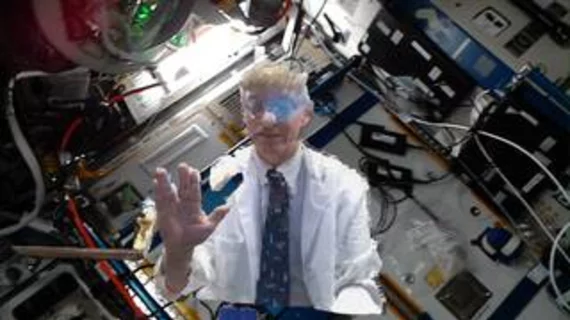NASA beams doctor virtually into space
Telemedicine has boomed in popularity during the COVID-19 pandemic, but remote healthcare isn’t just for homebound patients––it’s also now available to astronauts.
NASA recently virtually beamed up a flight surgeon to the International Space Station (ISS). Dr. Josef Schmid, industry partner AEXA Aerospace CEO Fernando De La Pena Llaca, and their teams were recently “holoported” to the ISS to have a two-way conversation with ESA (European Space Agency) astronaut Thomas Pesquet.
The experience was possible thanks to Microsoft’s “holoportation” technology, which enables users to interact with 3D representations of remote participants in real time. The tech uses high-quality 3D models of people to be reconstructed, compressed and transmitted live anywhere in real time. Participants need to wear Microsoft’s HoloLens to create a mixed reality display in order to interact with participants virtually in the same space.
“This is completely new manner of human communication across vast distances,” Schmid said in a NASA statement. “Furthermore, it is a brand-new way of human exploration, where our human entity is able to travel off the planet. Our physical body is not there, but our human entity absolutely is there. It doesn't matter that the space station is traveling 17,500 mph and in constant motion in orbit 250 miles above Earth, the astronaut can come back three minutes or three weeks later and with the system running, we will be there in that spot, live on the space station.”
The demonstration, during which Pesquet interacted with live images of Schmid and De La Pena at the ISS, is a precursor for what could come in future space missions. NASA plans to use the two-way communication to holoport people on Earth to space and astronauts back to Earth.
“We'll use this for our private medical conferences, private psychiatric conferences, private family conferences and to bring VIPs onto the space station to visit with astronauts,” NASA stated.
Next, NASA plans to combine holoportation with augmented reality to truly enable telementoring. The technology has exciting implications for deep space travel, and space agencies are currently working on solving communication delays for potential Mars missions.
“Imagine you can bring the best instructor or the actual designer of a particularly complex technology right beside you wherever you might be working on it,” Schmid said. “Furthermore, we will combine augmented reality with haptics. You can work on the device together, much like two of the best surgeons working during an operation. This would put everyone at rest knowing the best team is working together on a critical piece of hardware.”
While there is excitement for the technology in space settings, there are applications here on Earth, including reaching remote areas and bringing people together virtually for a variety of reasons. Telemedicine became critical during the COVID-19 pandemic, when patients delayed or put off routine care to reduce their exposure to the virus. Healthcare providers were given wider flexibilities to bill for remote healthcare services as a result.

